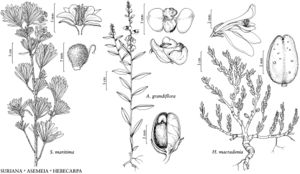Asemeia
Herb. Raf., 80. 1833.
| Taxon | Illustrator ⠉ | |
|---|---|---|
 | Suriana maritima Asemeia grandiflora Hebecarpa macradenia |
Herbs, perennial, sometimes suffrutescent, single to multistemmed. Stems usually erect, sometimes laxly spreading, pubescent or glabrous. Leaves alternate; petiolate; not strongly dimorphic; blade surfaces usually pubescent. Inflorescences terminal or axillary, racemes; peduncle present; bracts deciduous or persistent. Pedicels present. Flowers pink to purple (wings becoming green in fruit), chasmogamous, 5–9 mm; sepals persistent, lower 2 connate3/4 their length, distally 2-lobed, pubescent or subglabrous, sometimes marginally glandular-ciliate; wings persistent, (2.5–) 4–7 mm, pubescent or subglabrous; keel entire, without crest or beak, often with lateral folds, pubescent; stamens 8, not grouped into bundles of 4; ovary 2-loculed. Fruits capsules, dehiscent, margins not or very narrowly winged, glabrous or sparsely pubescent. Seeds densely pubescent, arillate, aril lobes vestigial or present.
Distribution
se United States, Mexico, West Indies, Central America, South America
Discussion
Species ca. 28 (1 in the flora).
Rafinesque considered Asemeia to contain two species of Polygala combined by Elliott under the name P. pubescens. He characterized the genus by its absence of a crest, tuberculate keel petal, and 2-loculed, winged capsule with two seeds; the absence of a crest is known in other species of Polygalaceae. It is not clear what Rafinesque meant by a tuberculate keel petal (although it may be a reference to the lateral folds often found on the keel). Most members of the traditional Polygala in the broad sense have 2-loculed capsules, winged in many species, with two seeds.
Selected References
None.